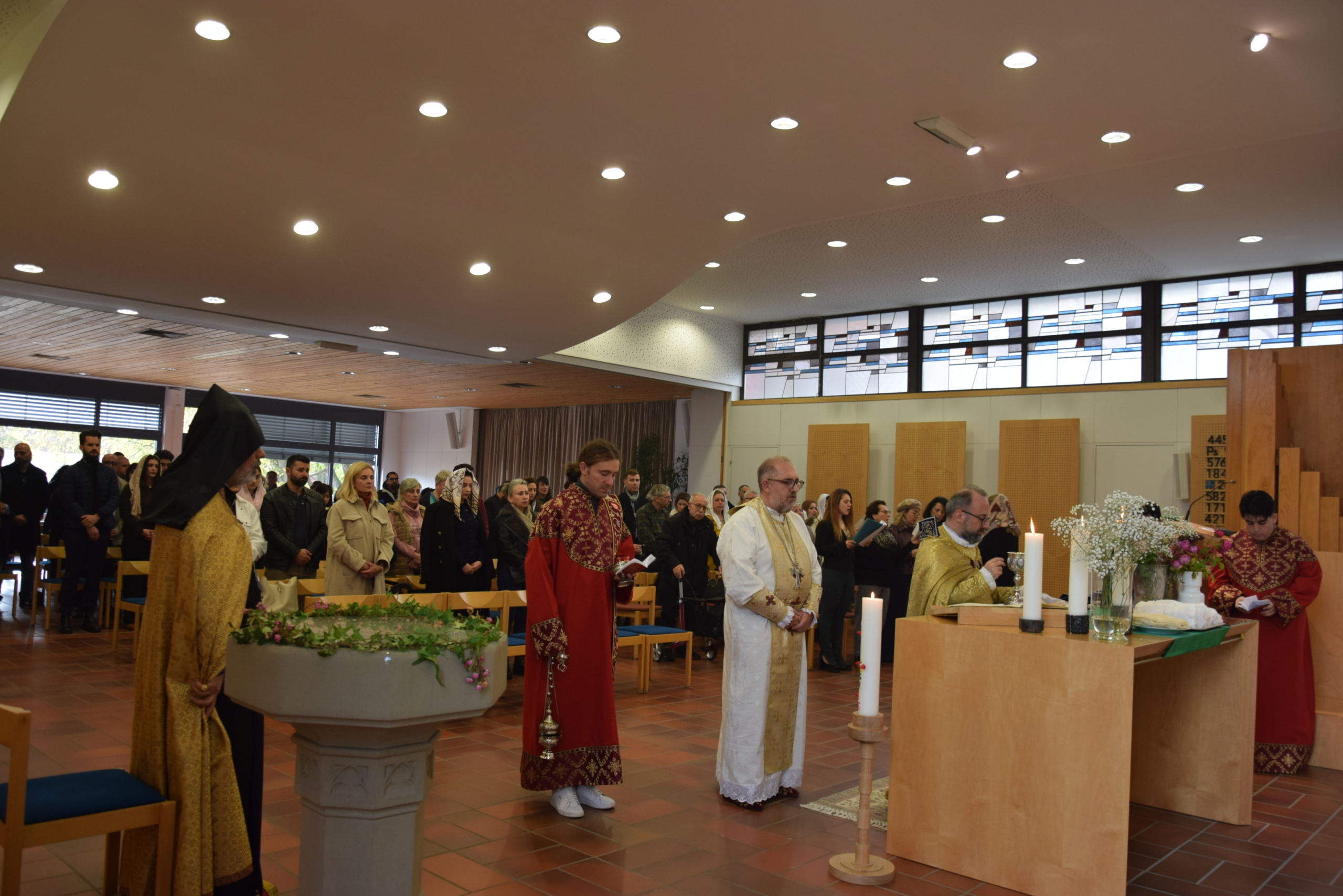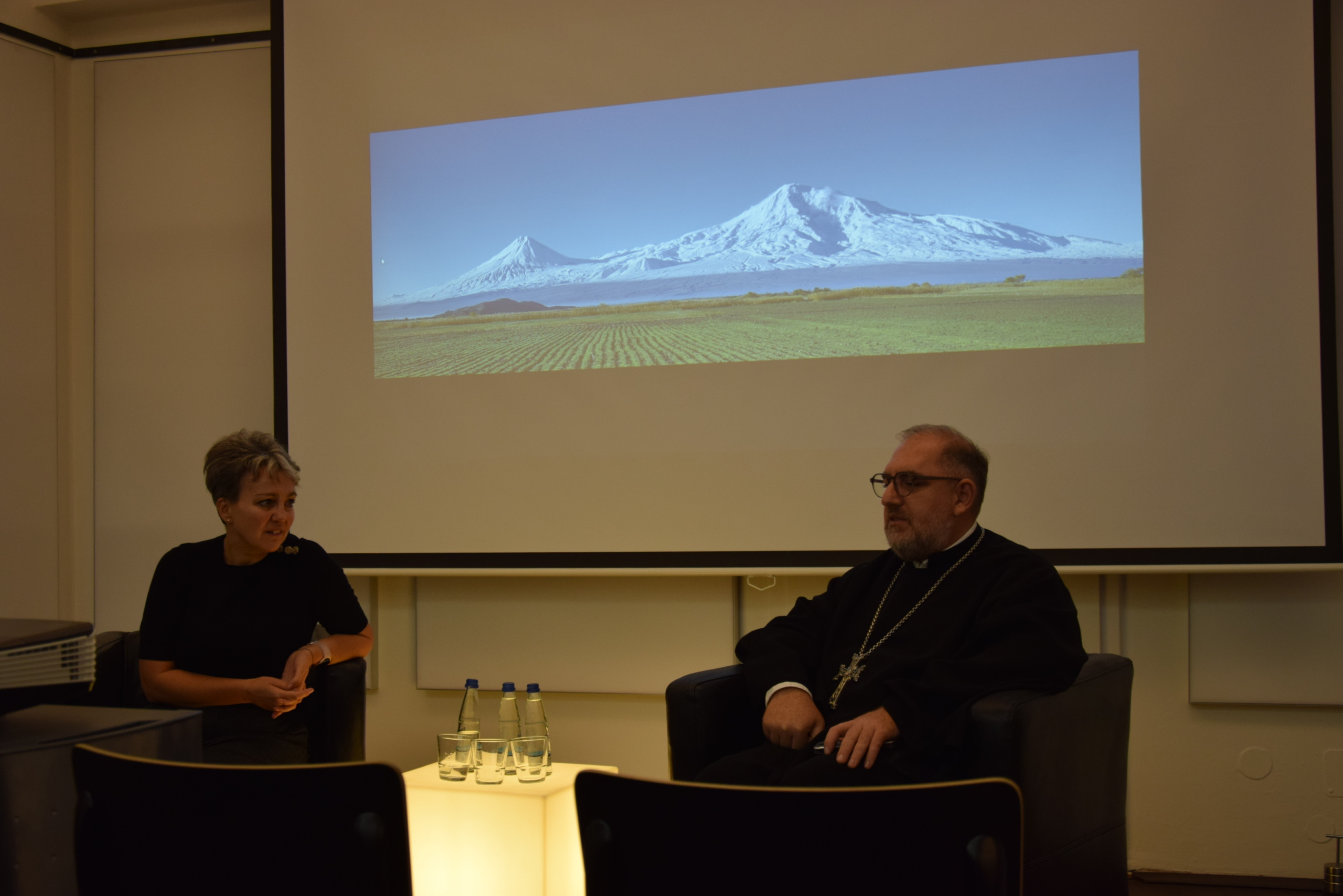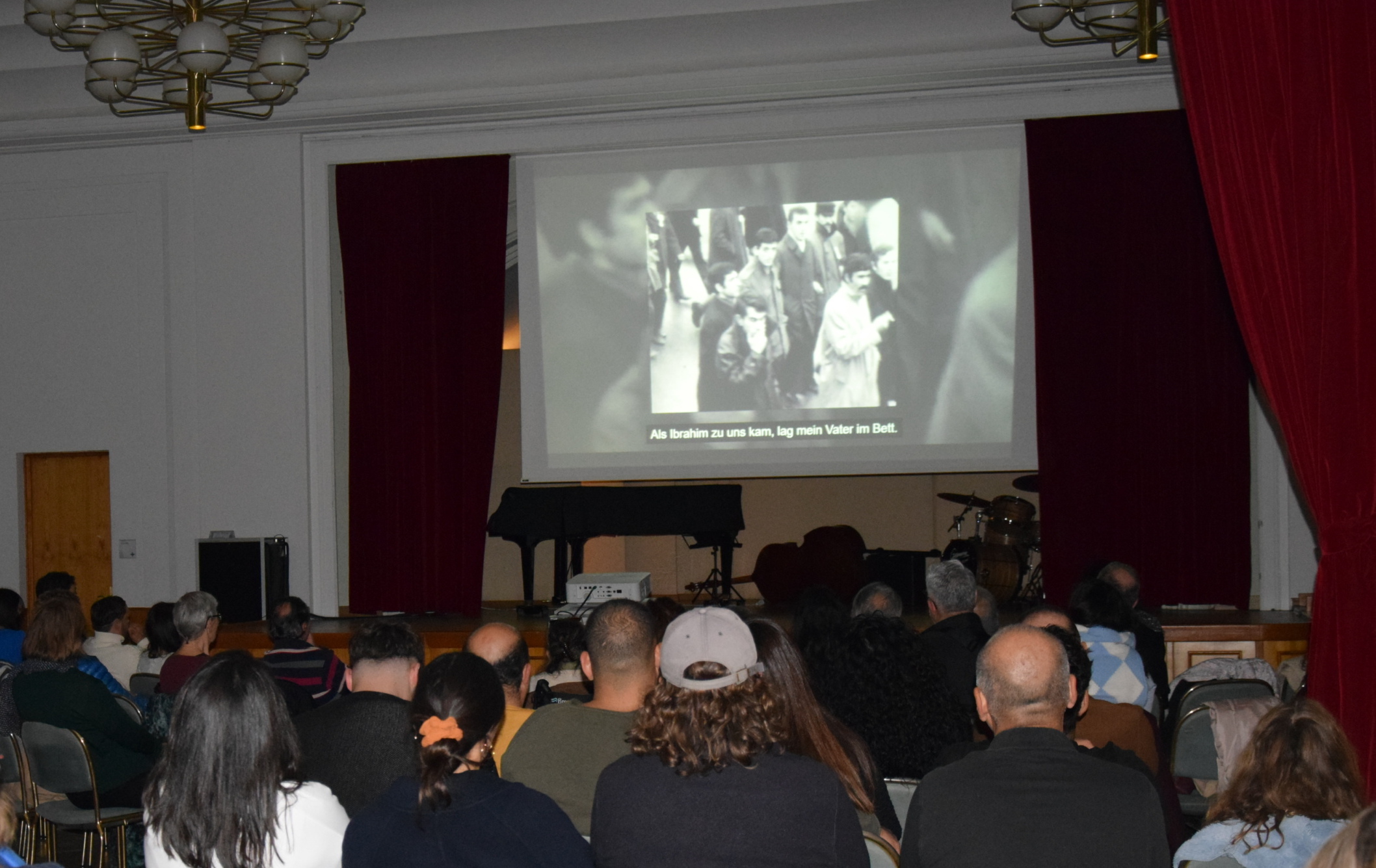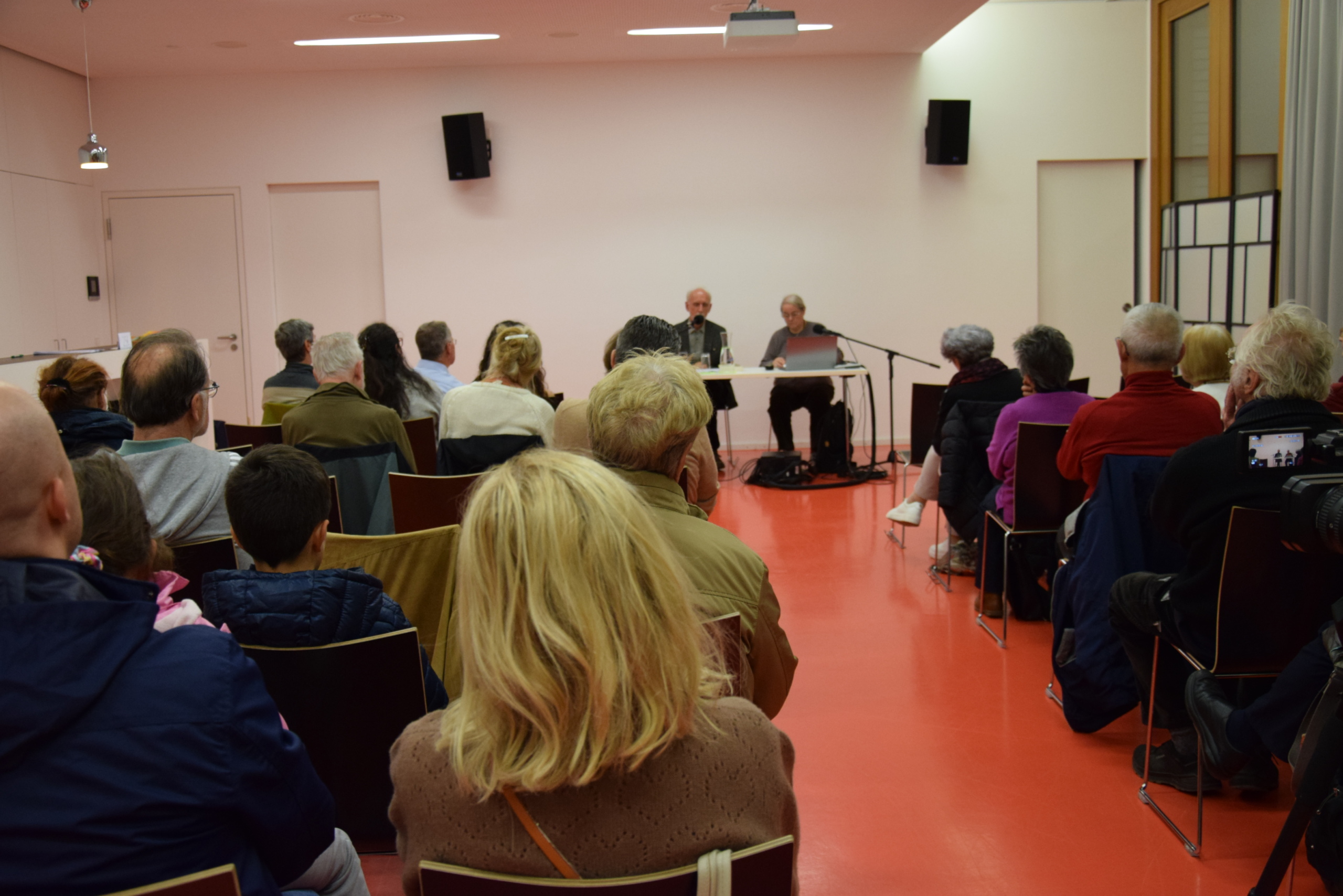Ein farbenprächtiges Gewebe aus Geschichte und Bewegung

Im Rahmen der Armenischen Kulturtage feierte gestern Abend im Kursaal die Deutschlandpremiere von „Khali“, einer fesselnden Tanztheater-Inszenierung der armenischen Choreografin Rima Pipoyan. Die Pionierin des zeitgenössischen Tanzes, bekannt für ihre einzigartige Verschmelzung von modernem Ballett, zeitgenössischer Bewegung und kulturellen Gesten, verwandelte die Bühne in ein lebendiges Tableau, das die uralte Kunst des armenischen Teppichs mit hypnotischer Kraft zum Leben erweckte. Das Publikum, sichtlich ergriffen, feierte die Aufführung mit tosendem Applaus und stehenden Ovationen – ein Beweis für die universelle Sprache der Kunst, die Tradition und Innovation in Einklang bringt.
„Khali“ erzählt die Geschichte eines armenischen Teppichs durch fünf virtuose Tänzerinnen – Milena Barseghyan, Milena Ghazaryan, Natella Baghramyan, Tamara Ghevndyan und Greta Alaverdyan –, die die Farben Rot, Blau, Bordo, Gelb und Grün verkörpern. Jede Farbe trägt eine eigene Erzählung, verwoben mit Symbolik und emotionaler Tiefe, doch im Zusammenspiel formen sie ein harmonisches Ganzes, das die jahrhundertealte Tradition der Teppichkunst als Akt der Erinnerung und des Neubeginns feiert. Pipoyans Choreografie ist ein meisterhaftes Wechselspiel aus Präzision und Poesie: Die Bewegungen der Tänzerinnen spiegeln das rhythmische Knüpfen und Verflechten der Fäden, während die Choreografie die Geschichten hinter den Mustern mit einer fast greifbaren Intensität erzählt. Besonders eindrucksvoll waren die Szenen, in denen die Tänzerinnen die Handarbeit der Weberinnen nachahmten, begleitet von den betörenden Klängen des Khazer Choir unter der Leitung von Hayk Karoyi. Die Kostüme von Qnqush Malkhasyan, in sanften Farben und dennoch von eleganter Schlichtheit, unterstrichen die Symbolik der Teppichfarben und verliehen der Inszenierung eine visuelle Tiefe, die das Auge ebenso fesselte wie die Bewegung.
Vor der Hauptvorstellung wurden zwei Kurzfilme von Pipoyan gezeigt, die ihre visionäre Vielseitigkeit unterstreichen. „Reek“, Teil des Environmental Dance Project, ist ein kraftvoller Kommentar zur Beziehung zwischen Mensch und Natur. In einer Müllhalde ringt die Tänzerin um Atem, ihr Körper von Staub und Schmutz bedeckt, während Szenen in Wüsten, Bergen und Wäldern ihre Sehnsucht nach Harmonie offenbaren. Der Film, visuell beeindruckend umgesetzt von Artur Gharayan, kontrastiert Zerstörung und Erneuerung und stellt eine dringliche Frage: Können wir unsere Verbindung zur Natur wiederfinden?
Der zweite Film, „Yel“, inspiriert von Komitas’ Adaption des armenischen Volkslieds „Yel, yel“, ist eine poetische Meditation über innere Kämpfe und die Suche nach Freiheit. Gedreht in der antiken Festung Erebuni, verschmelzen Tanz, Gesang und die statische Architektur Armeniens zu einem bewegenden Tableau über Verletzlichkeit und Widerstandskraft. Pipoyan selbst tanzt mit einer Intensität, die zwischen Fragilität und Stärke oszilliert, und macht „Yel“ zu einem universellen Aufruf zur Selbstüberwindung.
Die Bühnenperformance von „Khali“ war ein Triumph der Präzision, Leidenschaft und kulturellen Tiefe. Die Tänzerinnen beeindruckten durch ihre technische Brillanz und emotionale Hingabe, während Pipoyans Choreografie eine seltene Balance zwischen Tradition und Moderne fand. Ein Höhepunkt des Abends war die Interaktion mit dem Publikum: Nach der Aufführung erläuterten die Tänzerinnen die Symbolik der Teppichmuster und die Bedeutung der Fadenarbeit, was die kulturelle Resonanz des Werks noch vertiefte. Diese Geste der Vermittlung machte „Khali“ nicht nur zu einem ästhetischen Erlebnis, sondern auch zu einem Dialog über Erbe und Identität.
Rima Pipoyan, Gründerin der RP Dance Company und des Modern Dance Educational Systems, hat mit „Khali“ ein Werk geschaffen, das die Grenzen des Tanztheaters neu definiert. Ihre Fähigkeit, kulturelle Narrative in eine universelle Bewegungssprache zu übersetzen, macht sie zu einer der bemerkenswertesten Stimmen der zeitgenössischen Tanzszene. Dieser Abend im Kursaal war ein leuchtendes Beispiel dafür, wie Tanz Brücken zwischen Vergangenheit und Gegenwart, zwischen Kulturen und Generationen schlagen kann. „Khali“ ist nicht nur eine Hommage an die armenische Teppichkunst, sondern ein Plädoyer für die transformative Kraft der Kunst in einer zersplitterten Welt. Ein unvergesslicher Abend, der noch lange nachklingen wird.
“Khali”: A Tapestry of Armenian Heritage Woven in Dance
At the Kursaal last night, Rima Pipoyan’s Khali made its German premiere as part of the Armenian Cultural Days, delivering a mesmerizing fusion of dance, color, and history that left the audience enraptured. This tour de force by the Armenian choreographer, dancer, and visionary transformed the ancient art of Armenian carpet weaving into a vivid choreographic narrative, once again proving why Pipoyan is a trailblazer in contemporary dance. With Khali, she not only celebrates cultural heritage but also redefines the boundaries of modern ballet and storytelling through movement.
The performance centers on five dancers—Milena Barseghyan, Milena Ghazaryan, Natella Baghramyan, Tamara Ghevndyan, and Greta Alavderdyan—who embody the vibrant hues of an Armenian carpet: red, blue, burgundy, yellow, and green. Each color carries its own historical and emotional weight, yet together they weave a unified tapestry that speaks to resilience, memory, and renewal across generations. Pipoyan’s choreography is a masterclass in translating the tactile rhythm of weaving into dance. The dancers’ precise, flowing movements mimic the threading and knotting of fibers, creating patterns that pulse with life. Qnqush Malkhasyan’s costumes, bold yet refined, amplify the symbolic resonance of each hue, while Hayk Karoyi’s evocative score, performed by the Khazer Choir, envelops the stage in a haunting, rhythmic embrace.
What sets Khali apart is its ability to bridge the personal and the universal. The dancers’ interplay—sometimes synchronized, sometimes individual—mirrors the collaborative yet distinct labor of carpet weavers, while their gestures evoke the weight of cultural inheritance. A particularly poignant moment occurs when the ensemble pauses, hands tracing invisible threads, as if summoning stories from the warp and weft of history. After the performance, the dancers engaged the audience directly, elucidating the symbolism of the carpet’s patterns and the labor behind them—a rare and intimate gesture that deepened the evening’s resonance.
The program opened with two short dance films by Pipoyan, each a testament to her multifaceted artistry. Reek, part of the Environmental Dance Project, is a stark meditation on humanity’s fraught relationship with nature. A dancer, portrayed by Pipoyan herself, writhes amid a landfill’s detritus, her body caked in dust, before finding liberation in the expanses of desert, sea, and forest. Artur Gharayan’s cinematography juxtaposes suffocation with serenity, posing an urgent question: Can we reclaim harmony with our planet? The film’s global resonance, rooted in the synergy of dance and environmental activism, underscores Pipoyan’s commitment to art as a catalyst for change.
The second film, Yel, draws on Komitas’ adaptation of the Armenian folk song “Yel, yel,” a peasant’s plea to his ox, the lifeblood of his family. Shot at the ancient Erebuni Fortress, the film weaves dance, voice, and Armenia’s timeless architecture into a poetic exploration of inner struggle and resilience. Pipoyan’s choreography, set against the fortress’s weathered stones, captures a woman’s descent through fear and doubt toward self-overcoming. The cry of “Yel” (“Stand up”) becomes a universal anthem of perseverance, rendered with visceral intensity by Pipoyan and the Armenian State Chamber Choir. Both films, impeccably crafted, frame Khali as part of a broader artistic vision that melds tradition with urgent contemporary questions.Pipoyan, founder of the RP Dance Company and the Modern Dance Educational System, brings a singular voice to the global stage. Her work fuses modern ballet, contemporary movement, martial arts, and Armenian cultural gestures into a language that is both bold and poetic. In Khali, she transforms the specificity of Armenian carpet weaving into a universal ode to creation and continuity. The dancers’ technical brilliance and emotional depth, paired with Pipoyan’s visionary direction, created an evening of rare power. The audience’s standing ovation was not just applause but a collective acknowledgment of art’s ability to transcend borders and time.
Khali is a triumph—a performance that honors the past while speaking to the present, reminding us that dance, like a well-woven carpet, can hold stories that endure. For those fortunate enough to witness it, the Kursaal became a space where heritage and innovation danced as one.
AGBW
«Խալի»․ հայկական ժառանգությունը
արտահայտված պարի միջոցով
Շաբաթ, հոկտեմբերի 25-ին, Շտուտգարտի Կուրզալ Բադ-Քանշտադի մեծ դահլիճում կայացավ Ռիմա Պիպոյանի «Խալի» ներկայացման գերմանական պրեմիերան՝ «Հայ Մշակույթի Օրեր Շտուտգարտում» փառատոնի շրջանակում։ Հայ ժամանակակից խորեոգրաֆի, պարուհու և արվեստագետի այս բացառիկ բեմադրությունը միավորեց պարը, գույնը և պատմությունը՝ ստեղծելով հմայիչ սիմֆոնիա, որն ամբողջովին գերեց հանդիսատեսին։ Պիպոյանը, վաղուց ճանաչված որպես ժամանակակից պարի առաջամարտիկ, հնագույն հայկական գորգագործության արվեստը վերածեց շարժման և պատմության լեզվի՝ բացահայտելով ժամանակակից պարարվեստի նոր հորիզոններ։
Ներկայացման առանցքում են հինգ տաղանդաշատ պարուհիներ՝ Միլենա Բարսեղյանը, Միլենա Ղազարյանը, Նատելլա Բաղրամյանը, Թամարա Ղևոնդյանը և Գրետա Ալավդերյանը, որոնք մարմնավորում են հայկական գորգի հինգ հիմնական գույները։ Յուրաքանչյուր գույն ունի իր խորհրդանշական և զգացմունքային հնչողությունը, սակայն միասին նրանք հյուսում են մեկ ամբողջական պատկեր՝ տոկունության, հիշողության և վերածննդի պատմությամբ։ Պիպոյանի խորեոգրաֆիան իսկական վարպետության դաս է․ գորգահյուսության հնչյունային և շարժական ռիթմը վերածվում է պարի։ Պարուհիների հոսուն ու ճշգրիտ շարժումները հիշեցնում են թելի անցկացման ու հանգուցման ընթացքը՝ ստեղծելով կենդանի, շնչող պատկերներ։ Քնքուշ Մալխասյանի նրբաճաշակ զգեստները ընդգծում են յուրաքանչյուր գույնի խորհրդաբանությունը, իսկ Հայկ Կարոյի մեղեդային ու երբեմն խորհրդավոր երաժշտությունը՝ «Խազեր» երգչախմբի կատարմամբ, պարուրում է բեմը հուզական ու ռիթմիկ լարումով։
«Խալի»-ն առանձնանում է իր ունակությամբ միավորելու անձնականն ու համամարդկայինը։ Պարուհիների փոխազդեցությունը՝ երբեմն ներդաշնակ, երբեմն ինքնուրույն, հիշեցնում է գորգագործների համատեղ, սակայն յուրահատուկ ձեռագրերով աշխատանքը։ Նրանց շարժումներում զգացվում է մշակութային ժառանգության կշիռը։ Հուզիչ պահերից մեկն այն է, երբ պարուհիները դադարում են շարժվել՝ ձեռքերով միայն գծելով անտեսանելի թելեր, կարծես նոր պատմություններ են հյուսում ժամանակի ու հիշողության հյուսքից։ Ներկայացումից հետո պարուհիները զրուցեցին հանդիսատեսի հետ՝ բացատրելով գորգի նախշերի խորհրդաբանությունն ու դրանց ստեղծման նրբությունները՝ ստեղծելով մտերմիկ մթնոլորտ, որը խորացրեց երեկոյի տպավորությունը։
Ծրագիրը բացվեց Ռիմա Պիպոյանի երկու կարճամետրաժ պարային ֆիլմերով, որոնք վկայում են նրա բազմաշերտ տաղանդի մասին։
«Reek» ֆիլմը՝ «Environmental Dance Project»-ի շրջանակում, մարդու և բնության խաթարված հարաբերության փիլիսոփայական վերլուծություն է։ Պիպոյանը, հանդես գալով որպես գլխավոր դերակատար, շարժվում է աղբավայրի փոշու ու մնացորդների մեջ, ապա գտնում ազատություն անապատի, ծովի և անտառի անսահման տարածքներում։ Արթուր Ղարայանի օպերատորական աշխատանքը հմտորեն հակադրում է խեղդող փակությունը և ազատ շնչառությունը՝ հնչեցնելով հրատապ հարց՝ կարո՞ղ ենք վերագտնել ներդաշնակությունը մեր մոլորակի հետ։ Ֆիլմը միավորում է պարը և բնապահպանական մտահոգությունը՝ ընդգծելով Պիպոյանի հավատը արվեստին՝ որպես փոփոխության շարժիչ ուժի։
Երկրորդ ֆիլմը՝ «Ել», հիմնված է Կոմիտասի մշակած «Դե ել, դե ել» ժողովրդական երգի վրա՝ գյուղացու աղաչանքը իր եզին՝ ընտանիքի գոյության հենարանին։ Ֆիլմը նկարահանվել է հնագույն Էրեբունի բերդում և միավորում է պարը, ձայնը և Հայաստանի անմահ ճարտարապետությունը՝ վերածվելով ներքին պայքարի և տոկունության պոետիկ պատկերացման։ Պիպոյանի խորեոգրաֆիան՝ ամրակուռ բերդի քարերի ֆոնին, արտահայտում է կնոջ անցումը վախից ու կասկածից դեպի ինքնահաղթահարում։ «Ել» բացականչությունը («Վեր կաց») դառնում է համամարդկային դիմադրության ու հույսի կոչ, որն իր ամբողջ ուժով հնչում է Պիպոյանի և Հայաստանի Պետական Կամերային երգչախմբի կատարմամբ։ Երկու ֆիլմերն էլ իրենց գեղարվեստական կատարելությամբ ստեղծում են մի շրջանակ, որի ներսում «Խալի»-ն դառնում է ավանդույթի և արդիության ստեղծագործ միաձուլման հզոր արտահայտություն։
Պիպոյանը՝ RP Dance Company-ի և «Մոդեռն Պար» կրթական համակարգի հիմնադիրն ու գեղարվեստական ղեկավարը, բեմ է բերում յուրահատուկ ձայն և պատկեր ժամանակակից համաշխարհային արվեստի մեջ։ Նրա ստեղծագործությունները միավորում են բալետի դասականությունը, ժամանակակից շարժման արտահայտչականությունը, մարտարվեստների դինամիկան և հայկական ժեստերի խորհրդավորությունը՝ ձևավորելով մի նոր ոճ, միաժամանակ խիզախ և պոետիկ։ «Խալի»-ում նա հայկական գորգագործության յուրահատկությունը վերածում է համամարդկային ստեղծագործականության և շարունակականության օրհներգի։ Պարուհիների տեխնիկական փայլը և հուզական խորությունը՝ համադրված Պիպոյանի ներշնչող բեմադրության հետ, ստեղծեցին բացառիկ ուժով լի մի երեկո։ Դահլիճի երկարատև ծափահարությունները ոչ միայն շնորհակալություն էին, այլև համատեղ վկայություն, որ արվեստը կարող է հաղթահարել սահմաններն ու ժամանակը։
«Խալի»-ով Պիպոյանը ստեղծել է մի աշխատանք, որը վերաիմաստավորում է պարային թատրոնի սահմանները: Իսկ մշակութային պատմությունները համընդհանուր շարժման լեզվի վերածելու նրա կարողությունը նրան դարձնում է ժամանակակից պարային ասպարեզում ամենանշանավոր ձայներից մեկը:






